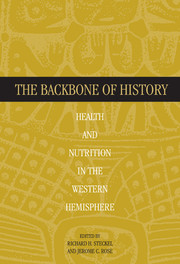Book contents
- Frontmatter
- Contents
- Preface
- List of Contributors
- PART I
- PART II METHODOLOGY
- PART III EURO-AMERICANS AND AFRICAN-AMERICANS IN NORTH AMERICA
- Introduction
- 5 The Health of the Middle Class: The St. Thomas' Anglican Church Cemetery Project
- 6 The Poor in the Mid-Nineteenth-Century Northeastern United States: Evidence from the Monroe County Almshouse, Rochester, New York
- 7 The Effects of Nineteenth-Century Military Service on Health
- 8 The Health of Slaves and Free Blacks in the East
- 9 The Quality of African-American Life in the Old Southwest near the Turn of the Twentieth Century
- PART IV NATIVE AMERICANS IN CENTRAL AMERICA
- PART V NATIVE AMERICANS AND EURO-AMERICANS IN SOUTH AMERICA
- PART VI NATIVE AMERICANS IN NORTH AMERICA
- PART VII
- PART VIII
- PART IX EPILOGUE
- Index
7 - The Effects of Nineteenth-Century Military Service on Health
Published online by Cambridge University Press: 01 March 2010
- Frontmatter
- Contents
- Preface
- List of Contributors
- PART I
- PART II METHODOLOGY
- PART III EURO-AMERICANS AND AFRICAN-AMERICANS IN NORTH AMERICA
- Introduction
- 5 The Health of the Middle Class: The St. Thomas' Anglican Church Cemetery Project
- 6 The Poor in the Mid-Nineteenth-Century Northeastern United States: Evidence from the Monroe County Almshouse, Rochester, New York
- 7 The Effects of Nineteenth-Century Military Service on Health
- 8 The Health of Slaves and Free Blacks in the East
- 9 The Quality of African-American Life in the Old Southwest near the Turn of the Twentieth Century
- PART IV NATIVE AMERICANS IN CENTRAL AMERICA
- PART V NATIVE AMERICANS AND EURO-AMERICANS IN SOUTH AMERICA
- PART VI NATIVE AMERICANS IN NORTH AMERICA
- PART VII
- PART VIII
- PART IX EPILOGUE
- Index
Summary
War is delightful to those who have had no experience of it. –
Desiderius ErasmusABSTRACT
During the nineteenth century, soldiers lucky or clever enough to avoid a bullet endured physical hardships that took a serious toll on their skeletons. The remains of 83 soldiers, spanning the Revolutionary War to the Battle of Little Bighorn, display the effects of these hardships. Conditions such as porotic hyperostosis, vertebral lesions, and dental caries and abscesses appeared at an early age among these soldiers. Low frequencies of chronic infection and moderate-to-severe skeletal deformities indicate that men with these conditions were not allowed to serve. The health index used in this study places the soldiers among the least healthy groups, supporting the conclusion that nineteenth-century military service turned relatively healthy young men into physical wrecks, unless they perished in combat first.
INTRODUCTION
As human endeavors go, war is particularly unsavory. Health and disease have impacted on the outcome of important battles and military campaigns at least until this century. Sick soldiers do not fight well.
Modern interpretations of the life of nineteenth-century soldiers are colored by firsthand accounts and broadly written historical works, usually focused on tactics and battles. Soldiers' diaries and generals' recollections rarely present the effects of military service on the bodies of young men. Certainly, military life was hard during the nineteenth century, but just how did it affect the musculoskeletal system of the soldiers? The skeletons of nineteenth-century soldiers provide unique evidence regarding the physical effects of military life.
- Type
- Chapter
- Information
- The Backbone of HistoryHealth and Nutrition in the Western Hemisphere, pp. 185 - 207Publisher: Cambridge University PressPrint publication year: 2002
- 8
- Cited by



